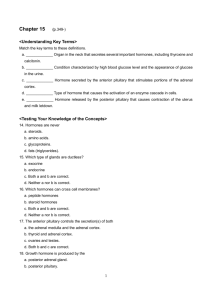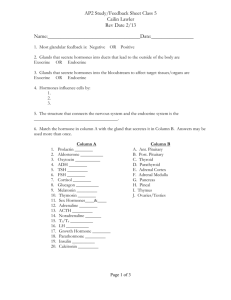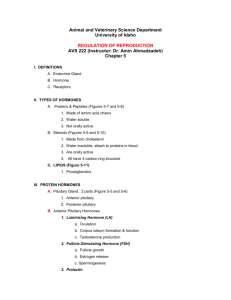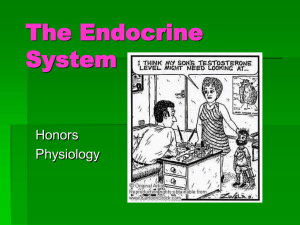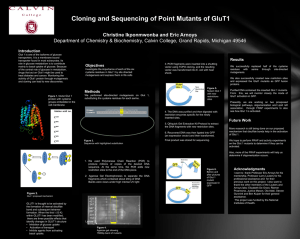Bios 1310 Exam 1 SI Review What is the term that is defined as “a
advertisement
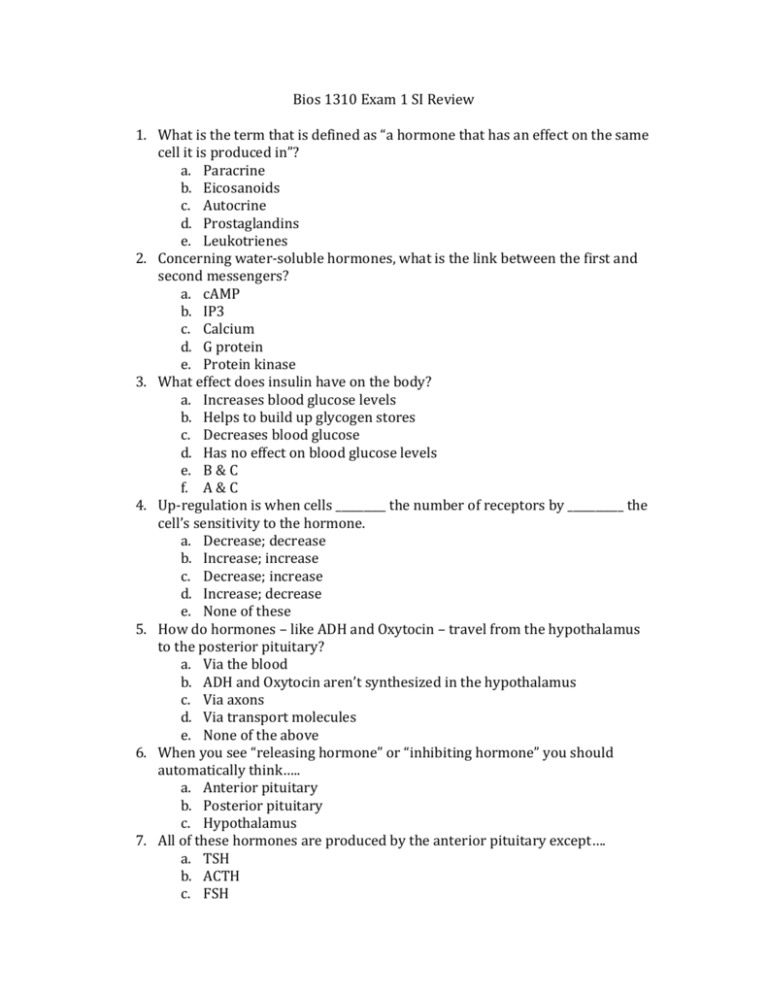
Bios 1310 Exam 1 SI Review 1. What is the term that is defined as “a hormone that has an effect on the same cell it is produced in”? a. Paracrine b. Eicosanoids c. Autocrine d. Prostaglandins e. Leukotrienes 2. Concerning water-soluble hormones, what is the link between the first and second messengers? a. cAMP b. IP3 c. Calcium d. G protein e. Protein kinase 3. What effect does insulin have on the body? a. Increases blood glucose levels b. Helps to build up glycogen stores c. Decreases blood glucose d. Has no effect on blood glucose levels e. B & C f. A & C 4. Up-regulation is when cells _________ the number of receptors by __________ the cell’s sensitivity to the hormone. a. Decrease; decrease b. Increase; increase c. Decrease; increase d. Increase; decrease e. None of these 5. How do hormones – like ADH and Oxytocin – travel from the hypothalamus to the posterior pituitary? a. Via the blood b. ADH and Oxytocin aren’t synthesized in the hypothalamus c. Via axons d. Via transport molecules e. None of the above 6. When you see “releasing hormone” or “inhibiting hormone” you should automatically think….. a. Anterior pituitary b. Posterior pituitary c. Hypothalamus 7. All of these hormones are produced by the anterior pituitary except…. a. TSH b. ACTH c. FSH d. ADH e. LH f. PRL g. GH h. MSH i. All of these are produced by the anterior pituitary 8. What is another name for the posterior pituitary gland? a. Adenohypophysis b. Neurohypophysis c. Thalamus d. Pineal e. A & B 9. What is the main function of the hormone melatonin? a. To control calcium levels in the blood b. To help with the coloration/pigmentation of the skin c. To control blood glucose levels d. To control sleep/wake cycles 10. What is the main function of EPO (erythropoietin)? a. To increase calcium reabsorption b. To increase sodium reabsorption c. Increase the number of white blood cells produced d. To increase the number of red blood cells 11. An example(s) of glucocorticoids is/are….? a. Aldosterone b. Testosterone c. Progesterone d. Cortisol e. Calcitriol f. There is more then one right answer 12. What is the function of the thymus gland? a. Control metabolic rate b. Stimulate/inhibit the release of other hormones c. Immunity d. Increased production of red blood cells e. None of the above f. All of the above 13. Individuals with hypothyroidism ________ weight and people with hyperthyroidism ________ weight. a. Lose, lose b. Gain, gain c. Lose, gain d. Gain, lose 14. Where are the receptors found for lipid soluble hormones? a. On the plasma membrane b. Within the cytoplasm c. On the nuclear membrane d. B and C e. A and B f. None of the above 15. What is a consequence of secreting or taking too much EPO? Select all that apply. a. Thicker/more viscous blood b. Decreased hematocrit c. Increased risk of blood clots d. Decreased risk of blood clots 16. What compound is vital to produce thyroid hormone? a. Iron b. Iodine c. Phosphorous d. Calcium 17. Normal blood glucose levels are from _____ to _______. a. 50-120 mg/dL b. 70-110 pg/dL c. 60-115 pg/dL d. 70-110mg/dL 18. ________________ is when glucose is converted to and stored as glycogen. a. Gluconeogenesis b. Glycogenesis c. Glycogenolysis d. Lipogenesis e. Lipolysis 19. How many heme are found in each hemoglobin. a. 1 b. 2 c. 3 d. 4 e. 8 20. What means “too many red blood cells”? a. Anemia b. Polycythemia c. Decreased hematocrit d. Thrombocytopenia 21. What type of protein structure is hemoglobin? a. Primary b. Secondary c. Tertiary d. Quaternary 22. What is iron called when found in the liver? a. Transferrin b. Heme c. Hemoglobin d. Ferritin 23. Urea is waste from….? a. Calcium b. Nitrogen c. Sodium d. Potassium e. Iron 24. How long do red blood cells? a. 10 days b. 52 days c. 120 days d. 160 days e. 365 days 25. What are the classic symptoms of Diabetes Mellitus? Select all that apply. a. Polyuria b. Polycythemia c. Polydipsia d. Polyphagia 26. What transmembrane protein aids the movement of glucose into the cell by facilitated diffusion? a. GLUT 1 b. GLUT 2 c. GLUT 3 d. GLUT 4 e. GLUT 5 27. Which is not considered a plasma protein? a. Fibrinogen b. Globulins c. Ferritin d. Albumins 28. What term means the resistance of a fluid to flow? a. Osmolarity b. Erythropoiesis c. Jaundice d. Viscosity 29. Which is a sign of increased levels of bilirubin in the blood? a. Edema b. Jaundice c. Cyanosis d. Glycemia 30. A patient with neither anti-A nor anti-B antibodies has what blood type? a. Type A blood b. Type 0 blood c. Type AB blood d. Type B blood 31. Which of the following allows an individual to determine “self” from “nonself”? a. Agglutinins b. Antigens c. Hematocrit d. Antibodies 32. What is the first white blood cell to attack bacteria? a. Monocyte b. Eosinophil c. Basophil d. Neutrophil 33. What two things do granules present on WBC contain? a. Histamine & heparin b. Iron & ferritin c. Antigens & antibodies d. Fibrin & fibrinogen 34. Which of the following is a precursor to the long, sticky, insoluble strand that makes a network for a clot to form? a. Ferritin b. Hemoglobin c. Fibrinogen d. Albumin 35. If a patient who has Type A blood accidentally receives Type B blood which of the following will occur first? a. Jaundice b. Agglutination c. Edema d. Pernicious anemia


